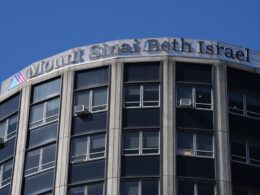Federal railway Amtrak is set to shut down one of the four tubes of the East River Tunnel starting Friday night, kicking off a larger overhaul that has faced opposition from the MTA, Gov. Hochul and an unlikely consortium of local elected officials.
The single tube closure, slated to last 10 days, is the first step in a two-and-a-half year repair project that will reduce the train capacity of the subterranean structure by 25%. The tunnel is used daily by Amtrak, Long Island Rail Road and New Jersey Transit trains.
“While I continue to believe this work could be accomplished without a full shutdown, I understand the importance of moving this project forward,” Hochul said in a statement following a meeting with Amtrak and Metropolitan Transportation Authority leadership Thursday.
“Amtrak has agreed to provide enhanced inspections, additional shift crews and the development of an operational response plan to help mitigate potential impact on commuters throughout the duration of the project,” she added.
The East River Tunnel, owned by Amtrak and first opened in 1910, consists of four tubes linking Manhattan and Queens. Two of the tubes — Nos. 3 and 4 — primarily serve the LIRR, the main user of the tunnel, allowing its service to Penn Station. The other two tubes — Nos. 1 and 2 — are used by Amtrak for service on the Northeast Corridor, and by NJ Transit for storage of commuter trains in Queens’ Sunnyside Yard.
Tubes 1 and 2 were inundated with salt water during Hurricane Sandy in 2012, and Amtrak has said the resulting corrosion of wires has played havoc with signaling and traction power in the tubes over the past decade. Railway officials also point to spalling concrete along the tunnel benchwall — the structure through which the tunnel’s high-voltage power lines run — that they say has been caused by the saltwater exposure.
On a recent press tour of Tube 2, Amtrak officials highlighted a slew of issues in the tunnel — from large gaps where the benchwall had crumbled to corrosion caused by groundwater incursion unrelated to Sandy.
Only a full shutdown of each tube, the officials said, would allow work crews to rebuild the benchwalls, replace all the wiring and make tweaks to the trackbed to improve drainage.
“The reliability of these tunnels is not going to get any better,” Amtrak spokesman Craig Schulz told reporters last week. “These tunnels are aged, they’ve been damaged by Superstorm Sandy, and they are in urgent need of repair.”

“The longer we delay this work, the more we risk the chance of service disruptions that are not acceptable to anybody,” he added.
After Amtrak closes Tube No. 1 to all train traffic Friday night, crews will conduct 10 days of work on this tube — shoring up third-rail infrastructure and making other tweaks — before reopening it, and then shutting down Tube No. 2 next.
If all goes according to plan, Tube No. 2 will then be closed for 13 months, during which time Amtrak crews will overhaul its tracks, wiring and benchwalls, effectively building a new tunnel in the shell of the old.
Three months after Tube No. 2 is complete, Amtrak will shut down Tube No. 1, and give it the same treatment.

During the two-and-a-half years when one of the four tubes will be shut to train traffic, the current LIRR and Amtrak schedules — both of which were slightly reduced as of November in anticipation of the shutdown — should, in theory, be unaffected.
But LIRR sources tell The News that signal failures inside all four tubes are somewhat common, and that it is not unusual to have a tube go out of service for hours while Amtrak crews are making repairs on it. While one tube is down for Amtrak’s upcoming overhaul, that means any relatively minor problem in another tube could leave the three railroads competing for space in just two tubes — for hours at a time.
As a result, MTA leadership has questioned the necessity of a full overhaul — and expressed concerns that even an hour of operations with potentially only two tubes operating could bring commuter train service to its knees.
LIRR President Rob Free said last week that Amtrak should be asking: “What [work] is absolutely essential, and only essential, to make sure the tunnels are in good condition?”

Evan Simko-Bednarski/New York Daily News
Corrosion from groundwater incursion visible in Tube 2 beneath the First Ave. ventilation shaft. (Evan Simko-Bednarski/New York Daily News)
Free and other MTA brass have called on Amtrak to adopt a similar approach to what the MTA did — unwillingly, at first — to repair similar corrosion damage in the L train’s Canarsie Tunnel.
The MTA’s eleventh-hour decision in 2019 to abandon the old electrical wiring inside the Canarsie Tunnel’s benchwall and mount new wiring on exposed racks along the tunnel’s length removed the need to demolish concrete infrastructure within the tunnel — averting a planned 15-month shutdown.
But Amtrak officials have repeatedly claimed that approach won’t work in this case — saying that while the 600-to-800-volt DC wiring in the Canarsie Tunnel could be left exposed, the 12,000-volt AC lines that run the overhead power for Amtrak and NJ Transit trains cannot.
Though similar high-voltage lines have been rack-mounted in other systems around the world — a 2020 report by independent experts at London Bridge Associates said such an approach was feasible on the East River Tunnel’s sister structure, the North River Tunnel beneath the Hudson — Amtrak officials say they’re committed to the additional layer of fire safety and insulation that a benchwall provides.

A diagram of the planned rebuild reviewed by the Daily News shows that Amtrak does indeed plan to use rack mounting for the tunnel’s lower-voltage wiring — including everything from radio communication to the tunnel’s signal system. The massive cables used to carry the high-voltage traction power that runs the trains, however, will be placed inside a new benchwall.
In a statement issued Thursday, an Amtrak spokesman said the meeting with Hochul and MTA officials had been “productive,” adding they would continue to monitor their work plan and make adjustments as necessary to minimize the impact on commuters.
“It is important to all of us this project is a success, so that all passengers, including Long Island and upstate New York residents and travelers, continue to have strong, reliable, on-time service now and in the future,” the statement read.








